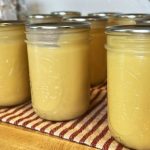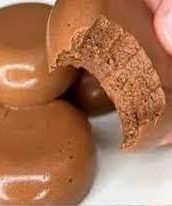Soft & Fluffy Gluten-Free English Muffins
A Morning Delight Without Gluten
Gluten-free English muffins are a breakfast staple that’s as versatile as it is delicious. They’re perfect with eggs, jam, or butter and are so soft and airy that no one will guess they’re gluten-free. If you’ve missed the taste and texture of classic English muffins because of dietary restrictions, this recipe is your solution.
The Science Behind Perfect Gluten-Free Muffins
Creating the perfect gluten-free bread is an art and science. Here’s everything you need to know to master this recipe.
- Choosing the Right Gluten-Free Flour
Instead of relying on store-bought mixes, this recipe uses a custom blend of:- White rice flour for lightness.
- Tapioca flour for elasticity.
- Brown rice flour for a subtle nutty flavor.
- Cornstarch for tenderness.
- Xanthan gum to bind the ingredients and mimic the structure that gluten provides.
- Moisture is Key
Gluten-free dough can easily become dry. Using both milk and water ensures the dough remains moist and tender. For a dairy-free option, substitute canned coconut milk. - Balance of Flavor
- Salt: Adds flavor and controls yeast activity.
- Sugar: Feeds the yeast and adds a hint of sweetness.
- Unsalted Butter: Adds richness and enhances the crumb. Dairy-free? Vegan butter works just as well.
- Eggs: Provide structure and stability to the dough.
- Cornmeal Magic
Sprinkling cornmeal on the cooking surface creates the characteristic texture and flavor of English muffins. If unavailable, the muffins will still taste great without it.
How to Make Gluten-Free English Muffins
This simple step-by-step guide will help you create bakery-quality English muffins at home.
Step 1: Activate the Yeast
Combine warm milk, warm water, sugar, and instant yeast in a bowl. Stir gently, then let it rest for 10 minutes. The mixture should bubble and foam, proving the yeast is active.
Step 2: Mix Dry Ingredients
Sift together white rice flour, tapioca flour, cornstarch, brown rice flour, xanthan gum, and salt in a large mixing bowl. This ensures an even distribution of ingredients.
Step 3: Form the Dough
Make a well in the dry ingredients and pour in the yeast mixture and eggs. Using a stand mixer with a paddle attachment, mix at medium-high speed until a sticky dough forms. Gradually add softened butter, one tablespoon at a time, until fully incorporated.
Step 4: Let It Rise
Transfer the dough to a greased bowl. Cover it with plastic wrap and a damp kitchen towel to create a warm, humid environment. Let it rise for about an hour until it doubles in size.
Step 5: Shape the Muffins
Dust a clean surface with gluten-free flour. Roll the dough into a rectangle about 1 inch thick. Use a 3-inch cookie cutter to cut out rounds. Transfer the rounds to a parchment-lined baking tray. Gather scraps, re-roll, and repeat until all the dough is used.
Step 6: A Second Rise
Cover the muffins with a clean kitchen towel and let them rest for 15 minutes. This ensures they’re fluffy and light.
Step 7: Cook to Perfection
Heat a non-stick pan over medium-low heat and sprinkle it with cornmeal. Place 3-4 muffins on the pan, leaving space between them. Cover with a lid and cook for 6-7 minutes on one side. Flip and cook for another 6-7 minutes. Repeat until all muffins are cooked.
Step 8: Serve and Enjoy
Allow the muffins to cool slightly before slicing them open with a fork. Serve them warm with butter, jam, or any topping of your choice.
Pro Tips for the Best Gluten-Free Muffins
- Storage: Keep muffins in an airtight container at room temperature for 3 days or refrigerate for up to a week.
- Freezing: Store in a ziplock bag for up to 3 months. Thaw in the fridge overnight before using.
- Versatility: These muffins are perfect for breakfast sandwiches, eggs benedict, or even mini pizzas.
Common Questions Answered
- What’s the difference between crumpets and English muffins?
Crumpets are made with a thinner batter, while English muffins use a dough. Crumpets also have a spongier texture. - Are store-bought English muffins gluten-free?
Most aren’t. Check the packaging carefully or make your own with this recipe! - Can I use a different flour blend?
You can experiment, but this specific blend yields the softest, fluffiest results.






